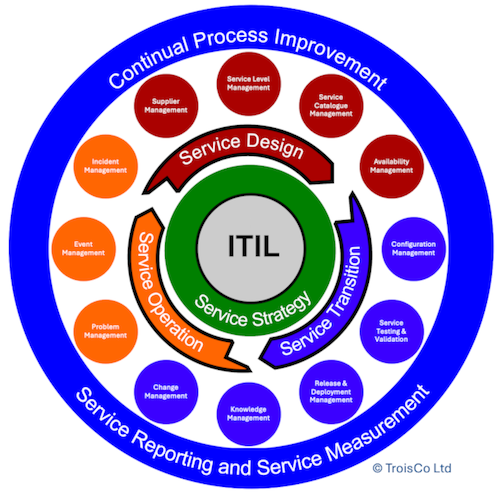Introduction to IT Service Management and the ITIL Framework

This introduction aims to provide a clear understanding of ITSM and ITIL’s role within it, setting up the context for deeper exploration in the subsequent sections which will follow as independent articles.
The Importance of IT in Modern Business
In today’s rapidly evolving technological landscape, the role of IT has transitioned from a support function to a core component of business strategy. Organizations across various industries increasingly rely on IT to drive innovation, enhance operational efficiencies, and deliver exceptional customer experiences. However, the growing complexity and scale of IT operations necessitate effective management to ensure these technologies deliver on their potential while aligning with business objectives.
What is IT Service Management (ITSM)?
IT Service Management (ITSM) is the discipline of designing, delivering, managing, and improving the IT services an organization provides to its end-users. It’s not just about managing IT services; it’s about ensuring these services deliver substantial business value, incorporating principles of quality management and customer service. Effective ITSM facilitates a structured approach to service management that helps align IT processes and services with business needs.
The Role of ITIL in ITSM
The Information Technology Infrastructure Library (ITIL) stands as the most widely adopted ITSM framework globally. Developed in the 1980s by the UK’s Central Computer and Telecommunications Agency (CCTA), ITIL provides a comprehensive, coherent, and cohesive set of best practices for managing IT services. Its focus is on aligning IT services with the needs of businesses and ensuring that the right processes, people, and technology are in place so that organizations can meet their strategic goals.
ITIL Framework Overview
ITIL’s strength lies in its comprehensive coverage of service management lifecycle components, which it breaks down into five main categories: Service Strategy, Service Design, Service Transition, Service Operation, and Continual Service Improvement. Each category encompasses a set of processes and practices necessary to manage and deliver IT services effectively.
Service Lifecycle Defines Key Components of ITIL
The core structure of ITIL is based on the service lifecycle, which consists of five stages that are critical to the management of IT services:
Service Strategy: This stage involves setting objectives and expectations, identifying the costs and potential ROI, and overall strategy formation for service management.
Service Design: Focuses on designing new IT services as well as changes and improvements to existing services. This includes designing the architecture, processes, policies, and documentation to meet current and future IT service needs.
Service Transition: Ensures that changes to services and service management processes are carried out in a coordinated way. It involves the transition of services from development to operations, including testing and quality assurance.
Service Operation: Deals with the day-to-day management of IT services. It aims to improve the quality of IT service delivery by ensuring that services are delivered in a way that meets business needs and user expectations.
Continual Service Improvement (CSI): Aims to continually improve the effectiveness and efficiency of IT processes and services, in alignment with business growth and changes.
The Evolution of ITIL
Since its inception, ITIL has evolved through several iterations, with ITIL v3 being one of the most significant updates before the transition to ITIL 4, which adapts the framework for the modern digital environment. ITIL 4 introduces a holistic approach to service management and integrates concepts from other methodologies like Agile, Lean, and DevOps, enhancing the framework’s flexibility and relevance in today’s fast-paced digital world.
Start of Series of Articles
As we delve deeper into each phase of ITIL in the following articles, we’ll explore the specific processes and best practices that can help any organisation enhance its IT service management capabilities. Whether you’re new to ITSM or looking to refine your existing practices, this guide aims to provide you with actionable insights and a deeper understanding of how ITIL can be leveraged to improve IT service delivery and align IT with business needs.
#ITIL # ITSM # ITserviceManagement #BestPractices
 By
By
